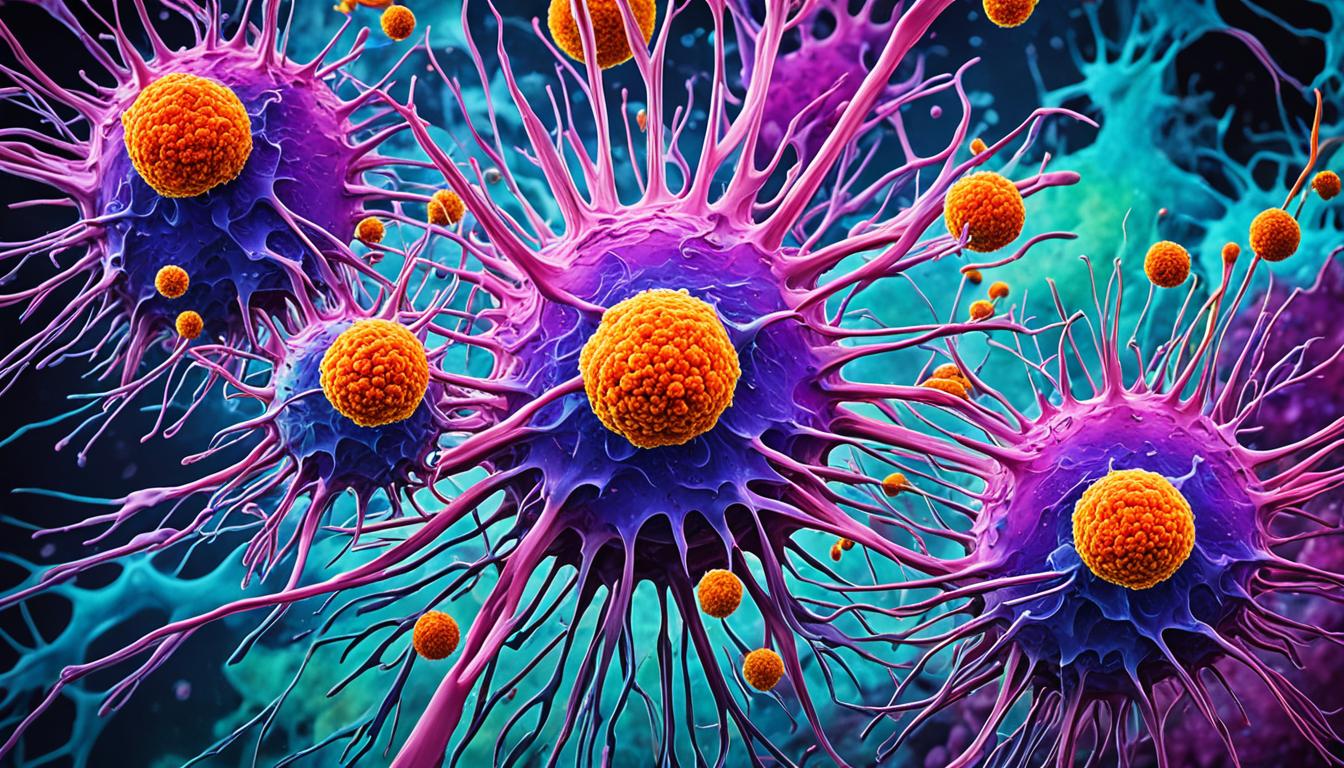Neurofibrosarcoma is a rare cancer that starts in the peripheral nerves. It makes up 8% to 16% of nerve sheath tumor cases. It’s often found in people with neurofibromatosis type 1. People with this cancer may feel pain, have a lump, and difficulty with their limbs.
Doctors diagnose neurofibrosarcoma through physical exams and imaging like CT or MRI. They also do a biopsy to check if it’s malignant. Treatment involves surgery and sometimes radiation or chemo. How well the patient does depends on the cancer’s grade and how much was removed.
Key Takeaways:
- Neurofibrosarcoma is a rare cancer of the peripheral nerves
- It’s more common in those with neurofibromatosis type 1
- Its symptoms include pain, a lump, and trouble with limbs
- Tests like physical exams and biopsies are used for diagnosis
- Surgery and possibly radiation or chemo are the usual treatments
Causes and Risk Factors of Neurofibrosarcoma
Neurofibrosarcoma is a complex disease with unknown causes. Certain factors make some people more likely to get it. One big factor is an inherited disorder called neurofibromatosis type 1 (NF-1).
NF-1 causes benign tumors on nerves, known as neurofibromas. In a few cases, these tumors can turn into neurofibrosarcomas. Having NF-1 greatly increases the risk of getting neurofibrosarcoma. This shows the important role of genetics in tumor growth.
Radiation exposure in the past could also raise the risk of neurofibrosarcoma. While radiation often helps treat cancer, it can also lead to new cancers like neurofibrosarcoma. The risk is higher if someone had a lot of radiation to treat cancer before.
Genetic Factors in Neurofibrosarcoma Development
Changes in certain genes play a key role in neurofibrosarcoma forming. For instance, the NF1 gene can be involved in both NF-1 and neurofibrosarcoma. The NF1 gene normally helps control cell growth. But when it’s mutated, cells can grow uncontrollably, leading to tumors.
It’s not a sure thing that everyone with a NF1 mutation will get neurofibrosarcoma. The relationship between genetics and the environment is very complex. We need more studies to understand how these interact in causing neurofibrosarcoma.
Risk Factors for Neurofibrosarcoma
The main risk factors for neurofibrosarcoma are NF-1 and previous radiation treatments. Knowing these risks helps doctors spot who might be more likely to get neurofibrosarcoma. With early diagnosis and proper care, outcomes for those with the disease can often be better.
| Risk Factors | Impact |
|---|---|
| Neurofibromatosis type 1 (NF-1) | Increases the risk of developing neurofibrosarcoma, along with other tumors |
| Past radiation exposure | Linked to the development of a small percentage of neurofibrosarcomas |
| Genetic mutations | Specific gene mutations, such as NF1, contribute to the development of neurofibrosarcoma |
Diagnosis and Treatment of Neurofibrosarcoma
To diagnose neurofibrosarcoma, doctors use many tests. They look at your symptoms and do tests like MRIs. This helps them see if there’s a tumor and find out more about it.
They may also do a biopsy. This is when they take a small piece of the tumor for testing. It’s the only sure way to know if it’s cancer.
If you have neurofibrosarcoma, you might need surgery, radiation, or chemotherapy. Your treatment plan depends on your specific case.
Surgery: Taking the tumor out is the first step. If the tumor is big or near important parts of your body, removing it might be hard. Sometimes, they might have to remove a limb to get all the cancer out. The goal is to remove the tumor without damaging too much and still keeping you looking as normal as possible.
Radiation therapy: After surgery, you might need radiation. It uses strong X-rays to kill any remaining cancer cells. This step is crucial for making sure the cancer doesn’t come back.
Chemotherapy: Chemo is another option. It takes the form of powerful medicines to stop cancer growth. You might get chemo if the tumor can’t be fully removed or if it’s moved to other parts of your body. This can help control the cancer and improve your chance of getting better.
The doctors who treat neurofibrosarcoma work together to create a plan just for you. They consider many factors, like your health and the cancer’s stage. This plan is meant to beat the cancer while keeping you as healthy as possible.
Conclusion
Neurofibrosarcoma is a rare cancer coming from peripheral nerves. It is tough to deal with because of its unique characteristics. It makes up only a small part of soft tissue sarcomas.
The cause of neurofibrosarcoma isn’t fully known. But, we do know that genes and being exposed to radiation before could lead to it. Doctors find it through detailed check-ups, images, and biopsies.
Normally, it’s treated with surgery, then radiation and maybe chemo. But, how well a person does really depends on different things. These include the grade of the tumor, when it was found, and if it was all taken out.
Especially, because it might come back even after heavy treatments. It’s clear that more must be done in terms of treatment for those with neurofibrosarcoma. This will make the outlook better for patients in the future.

